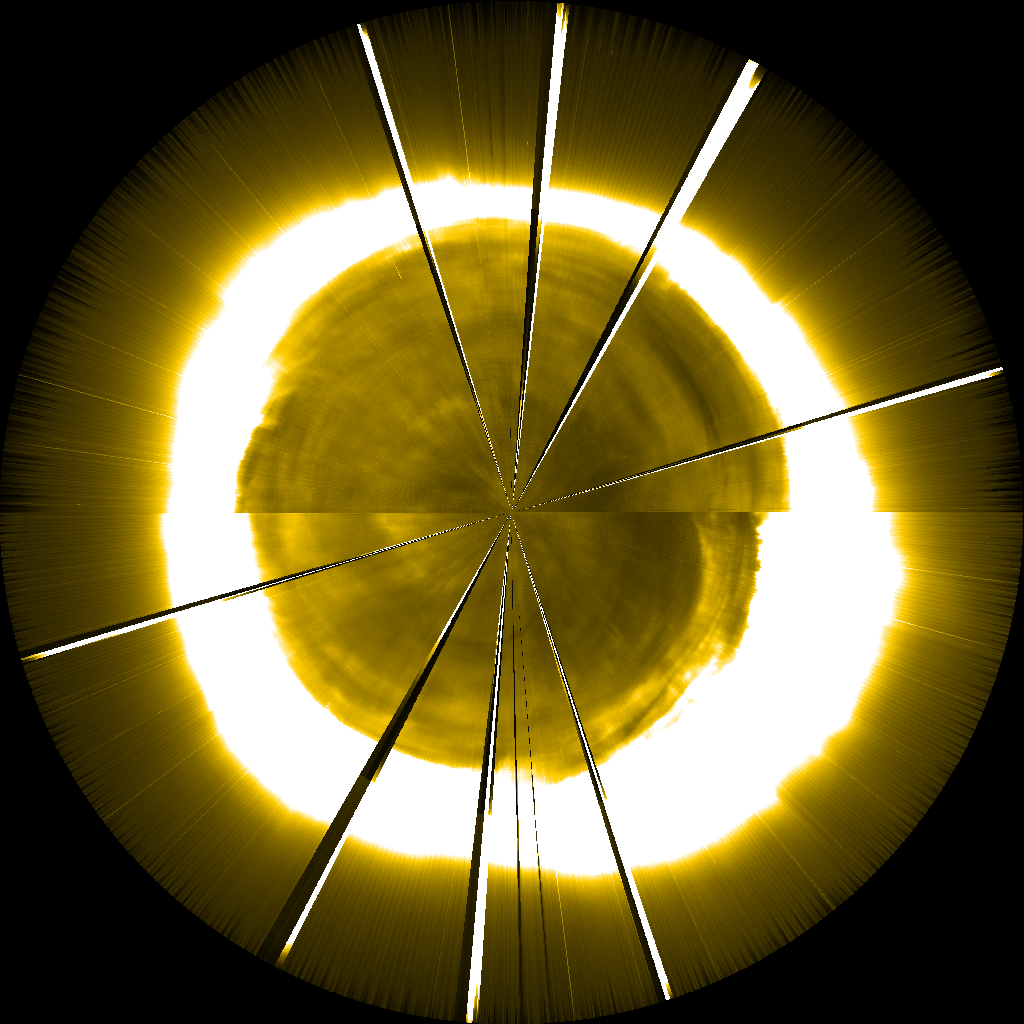Detector and Focal Plane Assembly
The detector is a technologically advanced CMOS (Complementary Metal Oxide Semiconductor) device coated with a scintillator layer to improve sensitivity in the EUV range. It has 1024 by 1024 pixels, each pixel having a 18 µm x 18 µm size.
This particular type of detector, called “High Accuracy Startracker” (HAS), is a radiation hardened, active pixel sensor (APS) detector.
The detector will be passively cooled with an external radiator viewing cold space to reduce thermal noise. This type of detector offers great advantages for space-based solar EUV imaging: radiation resistance, improved noise reduction, shutterless operation, and non destructive readout.
The focal plane assembly will also include the proximity electronics required to readout the sensor, a set of calibration lamps and a radiator viewing cold space to cool the detector through a cold finger. An additional feature is the decontamination heater, which will be used periodically to out-gas the condensed layer that builds up on the cold sensor (= bake-out process). Such deposits can absorb EUV radiation and dramatically decrease photon throughput.
The optical and focal plane assemblies will be mounted on an optical bench designed to provide mechanical stability and insensitivity to thermal variations. A lightweight invar structure will provide a degree of stability better than 50 µm between SWAP’s two mirrors.
Properties of the CMOS APS Detector
The CMOS ‘active pixel sensor’ (APS) detector has been developed as an alternative for CCD detectors in high-resolution, efficient digital X-ray and EUV imaging. In general, the use of CMOS technology offers several advantages over CCD technology:
- Every pixel can be read out separately so no shutter is needed.
- The power supply needed for a CMOS detector is negligible. This is important for SWAP since there are only 5 Watts available for the whole instrument.
- Camera-on-chip integration (camera control and interface logic is integrated on the chip)
The use of ‘active pixels’ largely optimizes the image quality which was - in the past - much lower in CMOS detectors than for CCD cameras. The integration of the amplifier inside the pixel results in low noise and a high light-to-voltage conversion gain. The usual drawbacks of this approach, a low photon-charge conversion and pixel non-uniformities or fixed pattern noise, are eliminated in the SWAP detector by using a pixel structure with a high fill factor and a compensation circuit for fixed pattern noise.
How Do SWAP’s Active Pixels Work?
Making a direct digital image involves converting the EUV radiation into a digital signal, which is a multi-step process:
- A conversion screen - the scintillator coating - is exposed to radiation and converts the EUV radiation into visible light.
- The pixel, in direct contact with the screen, converts the light into electrons that are then stored in a capacitor (voltages go down).
- When the capacitor discharges, the current is sent to an amplifier. Each CMOS pixel is configured with its own amplifier, a significant improvement over CCD detectors in which only one amplifier is available for each row of pixels in the array.
- The amplifiers are switched on and off by timing and control circuitry right on the chip, making additional circuitry adjacent to the panel unnecessary.
- The last step of the process is to perform analog-to-digital conversion of the signal that is done right at the sensor. In this process, the analog signal is converted into 12-bit binary code.
Scintillator coating
The scintillator layer on top of the CMOS detector consists of the phosphorus called “P43” which converts EUV radiation to visible light by the process of scintillation. The incoming radiation is absorbed (in this case EUV radiation at 17.5 nm) and light of a longer wavelength (visible light at 545 nm) is re-emitted, releasing the previously absorbed energy. The re-emitted visible radiation can then be detected by the active pixels of the CMOS detector. P43, the specific scintillator coating used in the SWAP detector, is a phosphorus made of the host material Gd2O2S which gets activated by Td.
Detector efficiency
The image is built assigning to each pixel a discrete value called DN (Digital Number) made by converting the analog signal to digital values. The DN/photon relation is:
DN = NUVphotons.QEP43.QECMOS.Gampli.GADC
where:
NUVphotons = number of UV photons reaching the coating surface [phUV]
QEP43 = scintillator efficiency [phVIS/phUV]
QECMOS = detector efficiency [e-/phVIS]
QE = QEP43.QECMOS = overall quantum efficiency of the coated detector [e-/phUV]
Gampli = gain of the programmable amplifier [V/e-]
GADC = gain of the analog-to-digital converter [DN/V]
OG = Gampli.GADC = overall gain of the detector [DN/e-]
The overall efficiency of the HAS APS is:
0.0186 DN/photon +/- 10% at 633 nm.
The quantum efficiency of the CMOS detector and the P43 coating separately are:
QECMOS = 0.45 e-/ph +/- 10%
QEP43 = 2.1 phVIS/phUV
so that the overall quantum efficiency of the coated detector at 17.5 nm is: QE = 0.945.
The largest signal that the sensor can capture is equal to 2493 DN.





